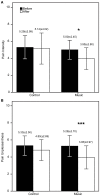Music reduces pain and increases functional mobility in fibromyalgia
- PMID: 24575066
- PMCID: PMC3920463
- DOI: 10.3389/fpsyg.2014.00090
Music reduces pain and increases functional mobility in fibromyalgia
Abstract
The pain in Fibromyalgia (FM) is difficult to treat and functional mobility seems to be an important comorbidity in these patients that could evolve into a disability. In this study we wanted to investigate the analgesic effects of music in FM pain. Twenty-two FM patients were passively exposed to (1) self-chosen, relaxing, pleasant music, and to (2) a control auditory condition (pink noise). They rated pain and performed the "timed-up & go task (TUG)" to measure functional mobility after each auditory condition. Listening to relaxing, pleasant, self-chosen music reduced pain and increased functional mobility significantly in our FM patients. The music-induced analgesia was significantly correlated with the TUG scores; thereby suggesting that the reduction in pain unpleasantness increased functional mobility. Notably, this mobility improvement was obtained with music played prior to the motor task (not during), therefore the effect cannot be explained merely by motor entrainment to a fast rhythm. Cognitive and emotional mechanisms seem to be central to music-induced analgesia. Our findings encourage the use of music as a treatment adjuvant to reduce chronic pain in FM and increase functional mobility thereby reducing the risk of disability.
Keywords: analgesia; fibromyalgia; functional mobility; music; pain.
Figures




References
-
- Benjamini Y., Hochberg Y. (1995). Controling the false discovery rate: a practical and powerful approach to multiple testing. J. R. Statist. Soc. B 57, 289–300
LinkOut - more resources
Full Text Sources
Other Literature Sources
Medical
Molecular Biology Databases

